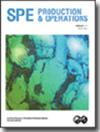多相流对含油碳酸盐岩地层基质酸化影响的定量研究
IF 1.3
4区 工程技术
Q2 ENGINEERING, PETROLEUM
引用次数: 3
摘要
在含油碳酸盐岩地层中注入酸性增产液以提高油井产能是很常见的方法。这种基质酸化工艺旨在通过优化注入参数(包括注酸速率和体积),最大限度地扩大虫孔在地层中的扩展。之前的研究表明,饱和度、渗透率、非均质性、温度和压力会显著影响基质酸化处理的设计。然而,实验室研究结果与他们的结论不一致,并且大多局限于水饱和岩心。在这项工作中,我们设计了一项系统的实验研究,以评估在向饱和原油的印第安纳石灰石岩心注入15%盐酸(HCl)时,多相流对酸化过程的影响。结果表明:与已发表的关于水饱和岩心的文献相反,在高压下对部分含油的高渗透岩心进行酸化所需的酸体积小于对低渗透岩心进行酸化所需的酸体积;与高压注酸相比,低压注酸可以在低渗透岩心中更有效地扩展虫孔;在低压条件下对低渗透岩心和高渗透岩心进行酸化,其效率相似;与水饱和岩心的低效率泄漏相比,虫孔在部分油饱和岩心中更有效,产生多个平行分支。本文章由计算机程序翻译,如有差异,请以英文原文为准。
Quantifying the Effect of Multiphase Flow on Matrix Acidizing in Oil-Bearing Carbonate Formations
It is common to inject acidic stimulation fluids into oil-bearing carbonate formations to enhance well productivity. This process of matrix acidizing is designed to maximize the propagation of wormholes into the formation by optimizing the injection parameters, including acid-injection rate and volume. Previous studies have suggested that saturation conditions, permeability, heterogeneity, temperature, and pressure can significantly affect the design of matrix-acidizing treatments. However, laboratory studies’ results are inconsistent in their conclusions and are mostly limited to water-saturated cores. In this work, we designed a systematic experimental study to evaluate the impact of multiphase flow on the acidizing process when injecting 15 wt% hydrochloric acid (HCl) into crude-oil-saturated Indiana Limestone cores. The results reveal the following: Contrary to published literature for water-saturated cores, acidizing in partially oil-saturatedhigh-permeability cores at high pressure requires less acid volume than in low-permeability cores; lower-pressure acid injection results in more efficient wormhole propagation in low-permeability cores compared to high-pressure acid injection; acidizing in low- and high-permeability cores at low pressure leads to similar efficiency; and wormholing is more effective in partially oil-saturated cores, resulting in multiple parallel branches as compared to inefficient leakoff in water-saturatedcores.
求助全文
通过发布文献求助,成功后即可免费获取论文全文。
去求助
来源期刊

Spe Production & Operations
工程技术-工程:石油
CiteScore
3.70
自引率
8.30%
发文量
54
审稿时长
3 months
期刊介绍:
SPE Production & Operations includes papers on production operations, artificial lift, downhole equipment, formation damage control, multiphase flow, workovers, stimulation, facility design and operations, water treatment, project management, construction methods and equipment, and related PFC systems and emerging technologies.
 求助内容:
求助内容: 应助结果提醒方式:
应助结果提醒方式:


